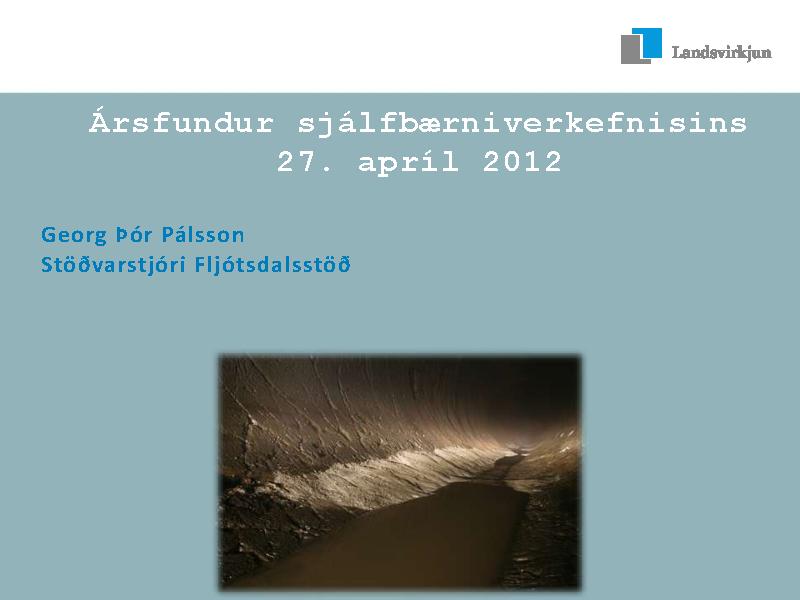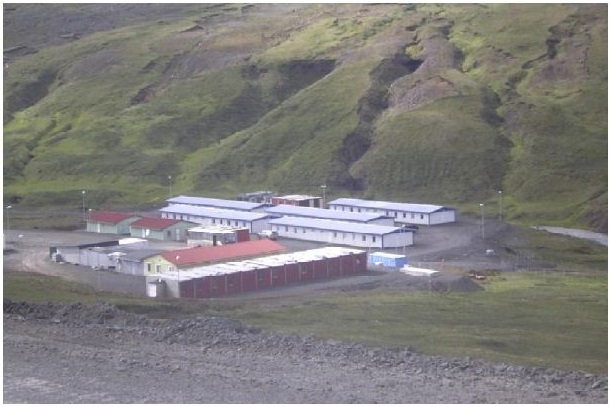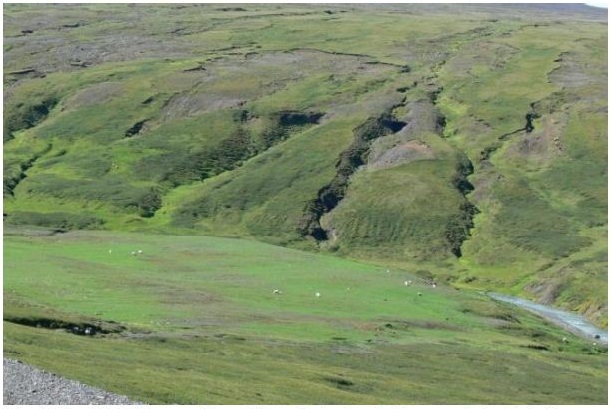Progress
All mine areas, soil and rock dump areas around the Alcoa Fjardaál smelter have been reclaimed. No mining areas were opened, especially for the project, as all material was removed from the site underneath the smelter.
Reclamation of mine and soil areas has been completed in the Fljótsdalur Power Station project area, focusing on these areas to fit as well as possible to the surrounding areas. However, one rock mine at Kelduárlón Reservoir is kept open for further use. The reclamation was carried out according to instructions from representatives of The Environment Agency of Iceland. A visual evaluation was used to assess the condition of the mine and spoil areas. Landsvirkjun will continue to monitor the mine and soil areas, even if they have been reclaimed and closed. The construction areas are regularly inspected, and an assessment is made of where vegetation needs to be strengthened with fertilizer application.
Fljótsdalsstöð's summer workgroup also travels around the areas and picks up rubbish that may be found there.
| Area | Size | Quantity of fertilizer | Quantity of seed | ||
|---|---|---|---|---|---|
| ha | kg | kg/ha | kg | kg/ha | |
| Fertilizer. - 300 kg/ha Seed - 10 kg/ha |
2 | 600 | 300 | - | - |
| Total | 2 | 600 | - | - | - |
More information concerning revegetation can be found in indicator 2.6.4 and LV-2023-053 (Icelandic only) under further reading.
The figures show an example of a work camp during the construction (Figure 1) and how these areas were reclaimed after the bases were removed (Figure 2). Furthermore, Landsvirkjun's report LV-2012-011 (Icelandic only) offers photos taken at different project stages.
Figure 1. Work camps at Glúmsstaðadalsá (11.7.2006)
Figure 2. The reclaimed area at Glúmsstaðadalsá (19.7.2010). All concrete foundations, wiring, and pipes were removed before the site was reshaped.
Updated: May 29, 2024
Source: Landsvirkjun (2024)
Metrics, Targets and Monitoring Protocol
What is measured?
Progress of vegetation in the project area (project effect: Indirect).
Monitoring Protocol
Power plant: During construction observers will visit the area and make sure constructors work according to plans. Measurements will be done if needed. Visual inspection every few months.
After construction mine and soil areas will be inspected and measurements made to see if it has been correctly leveled.
Revegetation areas will be visited annually, litter removed, and information gathered on vegetation status. Fertilizer will be spread, where needed.
Smelter: Through field engineering records. Data will be published once after the construction of the smelter is finished.
Targets
Smelter and power plant: The condition of disturbed areas is in harmony with the surrounding nature and landscape.
Possible countermeasures
Not applicable. All areas have been cleaned up. Monitoring only.
Updated: June 16, 2015
Changes of indicator
In annual meeting of the project in May 6 2015 following changes were approved:
| Original text | Changed text |
|---|---|
| Ratio of disturbed land reclaimed after construction. | Progress of vegetation in the project area |
| Original text | Changed text |
|---|---|
|
At the end of the construction period, information on the development of vegetation in revegetated areas will be collected every five years. |
Revegetation areas will be visited annually, litter removed, and information gathered on vegetation status. Fertilizer will be spread, where needed. |
Rationale for changes: The changes are made to adapt the monitoring protocol to what is done and is realistic. It is hard to declare when land is reclaimed and no standard scale available. Fertilizer induces vegetation but for the long run wild vegetation is the goal rather than species related to fertilizers. This will be monitored through annual visits to the area.
This indicator was originally number 20.1. It was then named Mine and Spoil reclamation and can be found under that number in documents of the project from 2005 and 2006.
The indicator number has been changed twice.
| Year | Nr. | Indicator name |
|---|---|---|
| 2020 | 4.4.3 | Cleanup at the construction sites |
| 2007 | 2.8 | Cleanup at the construction sites |
Baseline
Landscape and vegetation cover at the start of construction will be used as the baseline. The proportion of disturbed land that is reclaimed will be calculated by comparing pre-project landscape and vegetation cover in relevant areas after construction is finished and then every five years. This will be conducted in consultation with the Food and Environment Protection Agency.
Rationale for Indicator Selection
Large construction projects call for a large amount of material. Limiting disturbance of land and vegetation, as well as reclaiming the areas used for mines and spoils that are not inundated by the reservoir or become part of the construction, is a sustainability issue.
Material used to build dams and roads, as well as material used for other project related purposes, is taken from mines that are carefully chosen based on research and environmental considerations. To make land reclamation more successful, organic soil that is removed from disturbed areas will be kept and used to cover disturbed areas. Vegetation will also be restored where appropriate.
Earth material from tunnels, sections, and other digging related to the projects will be used for construction or placed in areas chosen after research and environmental considerations. Spoil areas that are not inundated by Hálslón Reservoir or otherwise affected by the projects will be shaped so they become a part of the current landscape. Organic soil from spoil areas will be stored until construction is completed. Then the disturbed areas will be covered with the soil and vegetation reclaimed where appropriate.
From phase I/II report on indicators and baseline from April 2005
Further reading

Ársfundur Sjálfbærniverkefnisins 27. apríl 2012
Erindi Georgs Þórs Pálssonar á ársfundi Sjálfbærniverkefnisins 2012
You can view more material related to the indicator by clicking on the link above.


